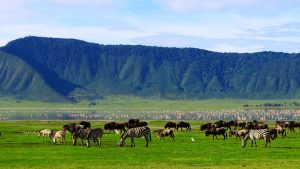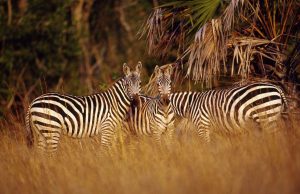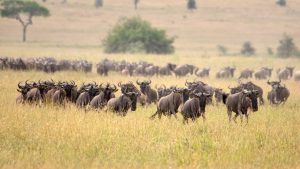
Ngorongoro Crater
The Ngorongoro Crater, situated in the northern region of Tanzania, is a captivating marvel that never fails to leave visitors in awe. Once an imposing
Serengeti National Park is located in Tanzania and is part of the larger Serengeti ecosystem which covers 12,000 square miles (30,000 sq km) and includes several other game reserves. The national park itself covers an area of 5,700 square miles (14,750 sq km). It is a GANP Ambassador Park and runs contiguously with the Masai Mara in Kenya.
The name Serengeti is derived from a similar Masai word which translates, “the place where land runs on forever.” It is also affectionately known as the “endless plains.” The area is comprised of grassland plains, savanna, riverine forest, and woodlands. Although the majority of the park is open plains, the elevation does vary from 3,000 to 6,000 feet (914 to 1,828 m). The lofty rock croppings spawn visions of the movie “Lion King,” and it is possible you may even see lions on them.
The Serengeti, Ngorongoro Crater, and Mount Kilimanjaro are almost inseparable when it comes to traveling to Tanzania. Visitors will almost always experience the three of these together. Ngorongoro Crater and the Serengeti share the migrating wildebeest, zebra and impala herds.
In general, the park is often described as three regions with boundaries of the national park. The primary area is the Serengeti plains where is where the wildebeest breed. A second area is a western corridor featuring black clay covered savannahs. This area is home to crocodiles and hippopotamuses. The hippo pool located near this region is a guaranteed place to see hippos sleeping and wallering around.
The third area is the northern Serengeti which is where the majority of hills and woodlands occur. This is the best place to find an elephant and a giraffe.
The Serengeti National Park is globally renowned for its abundance and variety of wildlife as well as high biodiversity. The Big 5 (lion, leopard, elephant, rhino, and buffalo) can all be experienced in the park. Except for the mountain gorilla, all of Africa’s Big 7 (lion, leopard, elephant, rhino, hippo, and crocodile) can be found in the national park.
Predators beyond the lion and leopard include cheetah, hyena, jackals, African golden wolf, honey badger, serval, and the African wild dog. Because the park landscape is so open, there is a fair chance that you will see most of the predator species. Keep your eyes open for gathered safari vehicles; you can almost guarantee if there are more than three gathered together, they are looking at lion or leopard.
The largest remaining unaltered mammalian migration in the world is the pinnacle wildlife experience of the Serengeti. The migration features over 1.3 million wildebeest, 250,000 zebra, 500,000 gazelles, and tens of thousands of topi, hartebeest, and impala. This statistic is one of the main reasons the migration was selected as one of the Seven Natural Wonders of Africa.

The Ngorongoro Crater, situated in the northern region of Tanzania, is a captivating marvel that never fails to leave visitors in awe. Once an imposing

A calming coastal breeze blows through the palm trees. Under the tropical heat, white sand and blue ocean glitter seductively. Swahili fishermen cast their nets

Serengeti National Park is located in Tanzania and is part of the larger Serengeti ecosystem which covers 12,000 square miles (30,000 sq km) and includes